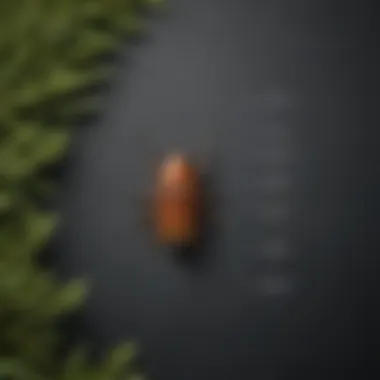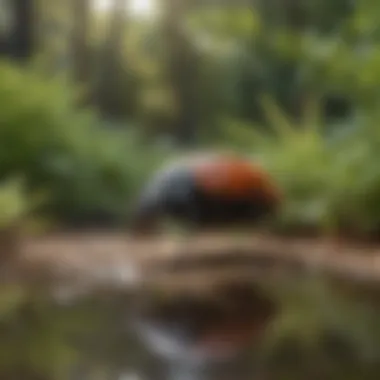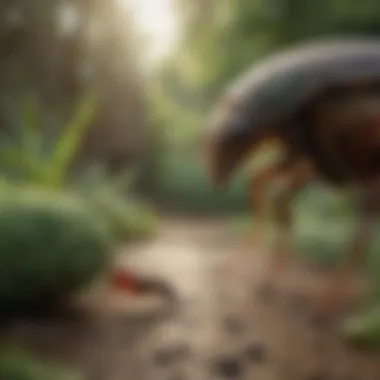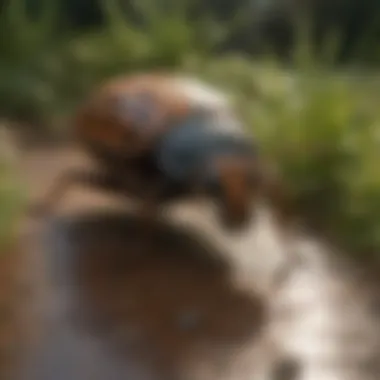Off Backyard Bug Control vs Cutter: A Comparative Analysis


Intro
In the realm of backyard pest control, homeowners face a complex decision. Selecting between Off Backyard Bug Control and Cutter can greatly influence the effectiveness of pest management efforts. With a variety of bugs such as mosquitoes, ticks, and fleas, it becomes paramount to understand the properties of these products. Each has its own unique formulation and intended use.
Furthermore, understanding the common pests and their behaviors is crucial for effective control. Pests can vary from season to season, and their presence can lead to various health issues and discomfort. This article aims to dissect the features of Off and Cutter, comparing them on effectiveness, safety, application methods, and additional user experiences. By delving into these details, this guide serves as a reference to make informed decisions.
Pest Identification
Identifying pests is the first step in formulating a suitable control strategy.
Detailed Descriptions of Common Pests
- Mosquitoes: Small, flying insects that are often found near standing water. They feed on the blood of humans and animals, causing irritation and can transmit diseases like West Nile Virus.
- Ticks: Arachnids that latch onto mammals, birds, and sometimes reptiles. Tick-borne diseases, such as Lyme disease, make them a significant concern.
- Fleas: Small, wingless insects that are predominantly found on cats and dogs. Their bites can produce itchiness and allergic reactions in pets and humans.
- Wasps: Winged insects that can be aggressive if their nests are disturbed. They can sting multiple times and sometimes require careful removal.
Signs and Symptoms of Infestations
Identifying an infestation promptly can mitigate further issues.
- Mosquitoes: Frequent buzzing sounds, bites on skin during outdoor activities.
- Ticks: Finding ticks on pets or humans after outdoor excursions, unusual rashes or flu-like symptoms.
- Fleas: Pets scratching often, flea dirt on fur, and bites on illustrations of less hairy areas of the human body.
- Wasps: Sightings of wasps near nests, increased activity in late summer.
Prevention Strategies
To reduce reliance on chemical treatments, effective prevention strategies can be beneficial.
Home Maintenance Tips for Pest Prevention
- Eliminate Standing Water: Regularly check areas where water may accumulate, such as bird baths and clogged gutters.
- Seal Gaps: Inspect the home for gaps in windows and door frames and seal them to prevent entry.
- Maintain Landscaping: Keep shrubbery trimmed and grass cut to reduce hiding spots for pests.
Natural Deterrents and Barriers
Employing natural deterrents can complement chemical treatments.
- Essential Oils: Certain oils like citronella and eucalyptus can repel insects when used in diffusers.
- Garlic Spray: A mixture of garlic and water can deter pests when applied to the garden.
Treatment Options
When prevention fails, choosing the right treatment method is key.
Overview of Chemical vs. Natural Treatments
- Chemical Treatments: Products like Off Backyard Bug Control and Cutter use active ingredients designed for immediate relief from pests, often with longer-lasting effects.
- Natural Treatments: These include non-toxic repellents and solutions that may require more frequent application but are safer for children and pets.
Step-by-Step Guides for DIY Treatments
For those inclined towards DIY, proper techniques can enhance effectiveness.
- Prepare a Natural Repellent: Combine water with vinegar and essential oils in a spray bottle.
- Test Application: Apply the mixture to a small area to ensure no adverse reactions occur.
- Full Application: Spray on areas commonly infested, such as seating areas in the backyard or pet resting spots.
"The success of any pest control measure often lies in the correct identification and proactive approach to prevention."
With the right knowledge about pest identification, prevention strategies, and treatment options, homeowners can navigate their pest control challenges with greater clarity. This sets the foundation for deeper analysis between Off Backyard Bug Control and Cutter in the sections that follow.
Preamble to Backyard Bug Control
Backyard bug control is a critical topic for homeowners and property managers. Pests can not only disrupt outdoor enjoyment but can also pose risks to health and property. Understanding how to effectively manage these intruders ensures a pleasant and safe environment.
In this section, we will focus on the significance of pest management strategies and look at the most common threats that backyard pests present.


The Importance of Pest Control
Pest control plays a vital role in maintaining an attractive and functional outdoor space. Unchecked pest populations can damage plants, spread diseases, and create an uncomfortable atmosphere. Homeowners often face challenges from mosquitoes, ticks, and other nuisances that thrive in their gardens.
Effective pest control helps protect your family from health hazards such as Lyme disease or West Nile virus. Some pests also jeopardize landscaping investments. As such, addressing these issues promptly can save both time and money in the long run.
Overview of Backyard Pests
There are various pests commonly found in residential backyards, including:
- Mosquitoes: These insects are notorious for invading yards, especially in warmer months.
- Ticks: They can carry serious illnesses and are often found in wooded or grassy areas.
- Ants: While some are harmless, certain species can invade homes and create nuisances.
- Bugs: Aphids and beetles can cause significant damage to plants.
Recognizing these pests is the first step in managing them effectively. By identifying specific threats, homeowners can select the appropriate products and methods for control. Ultimately, a thorough understanding of backyard pest behaviors and life cycles supports informed decision making in pest management.
Understanding Off Backyard Bug Control
Off Backyard Bug Control is a significant product in the realm of pest management. This section will discuss various aspects of this product, which will help homeowners understand its function and utility in their gardens or yards.
Product Composition and Ingredients
The composition of Off Backyard Bug Control is crucial to its efficacy. The active ingredients typically include DEET, which is effective in repelling various insects. Additionally, there are essential oils like citronella or geraniol used for their insect-repelling properties.
Understanding these ingredients helps consumers gauge safety and effectiveness. Off products are designed primarily for outdoor use and aim to create a barrier against mosquitoes and similar pests. Other components in its formulation may contribute to texture and spreadability, enhancing the user experience.
Application Methods
Correct application of Off Backyard Bug Control is vital for achieving optimal results. Users are advised to spray the product evenly over exposed skin and clothing while maintaining a distance of about six to eight inches. This distance is crucial to avoid over-saturation in one area which can lead to skin irritation.
The timing of application also matters. Ideally, it should be used before outdoor activities, especially in areas known for high insect activity. This proactive approach ensures effective treatment and ongoing protection from pests.
Effectiveness in Pest Control
The effectiveness of Off Backyard Bug Control largely depends on the specific pest one aims to control. In many cases, it has proven effective against mosquitoes, ticks, and black flies. Many users report a significant reduction in insect presence when using this product. However, it is important to note that results can vary based on environmental factors.
Some users have not experienced the same level of efficacy, particularly in areas with a high concentration of pests. A common recommendation is to combine Off with other pest control methods for improved results. In moderate infestations, Off can be a satisfactory solution, while in more severe situations, professional pest control may be advisable.
In summary, Off Backyard Bug Control serves as a practical choice for many homeowners seeking to enjoy their outdoor spaces without the nuisance of pests. By understanding its ingredients, application methods, and effectiveness, consumers can make informed decisions about their pest management strategies.
Exploring Cutter as a Bug Control Solution
When discussing backyard pest control, Cutter emerges as a favored option for homeowners. The effectiveness of such products hinges on a few essential elements, including the active ingredients, methods of application, and overall effectiveness against common pests. This section will analyze these components in greater detail, making it easier for the reader to understand how Cutter may meet their specific pest control needs.
Active Ingredients Overview
Cutter utilizes several active ingredients designed to repel and eliminate common backyard pests. Among these, Picaridin is a prominent choice. This compound is known for its effectiveness against mosquitoes, ticks, and other biting insects. Unlike DEET, Picaridin does not possess an oily texture or strong odor, making it more appealing for many users. Another compound found in certain Cutter products is Oil of Lemon Eucalyptus, which is a natural repellent that has shown comparable efficacy to synthetic repellents.
These ingredients serve specific purposes:
- Picaridin: Provides long-lasting protection against mosquitoes and ticks.
- Oil of Lemon Eucalyptus: A natural alternative that repels insects effectively without the harsh chemicals.
Understanding the composition of Cutter helps in assessing if its use aligns with personal values and preferences regarding both efficacy and safety.
Method of Application
Application methods for Cutter vary based on the specific product form, which can include sprays and lotions. The flexibility of application options contributes to its popularity. For instance, spray forms allow for quick and easy coverage of affected areas, while lotion options provide targeted application on skin. Here are some key points about application methods:
- Sprays: Ideal for large areas, the aerosol format ensures an even spread. The user must hold the canister a specific distance from the intended area for optimal results.
- Lotions: Commonly used for direct skin application, these products require careful consideration to ensure full coverage. Users are advised to apply evenly, especially in areas prone to bug bites.
Regardless of the chosen method, following instructions is crucial for optimal effectiveness.


Comparative Effectiveness
The effectiveness of Cutter can be evaluated by comparing it to other pest control solutions, particularly Off. User experiences suggest that Cutter tends to provide longer-lasting protection against mosquitoes. Many reviews highlight that Cutter may maintain efficacy for several hours despite outdoor conditions. The extent of effectiveness can depend on various factors, including environmental conditions, pest types, and frequency of reapplication.
Furthermore, effectiveness can vary based on individual preferences. While some users prioritize longevity of protection, others may seek a more natural option. In this light, Cutter's formula may be especially appealing, as it contains both synthetic and natural ingredients. This dual approach can cater to different user needs and preferences.
"Cutter combines the benefits of synthetic and natural ingredients, offering a versatile solution for managing backyard pests."
In closing this exploration, Cutter remains an important player in the landscape of bug control solutions. By focusing on its active ingredients, methods of application, and effectiveness, homeowners can make more informed choices that align with their pest management goals.
Comparative Analysis: Off vs. Cutter
Efficacy Against Specific Pests
The effectiveness of pest control products varies significantly based on their active ingredients and formulation. Off Backyard Bug Control is designed primarily to target mosquitoes, but it can also reduce the presence of other backyard pests such as biting flies and gnats. Its active ingredients, typically DEET or oil of lemon eucalyptus, are known for their repellent properties, making them suitable for outdoor activities. In contrast, Cutter is broader in its target range, effectively addressing a variety of insects, including mosquitoes, ants, and ticks. Its ingredients, which often include synthetic pyrethroids, not only repel but also kill pests upon contact.
This factor is crucial for homeowners. For instance, if an individual is particularly concerned about ticks, Cutter might be the preferred option due to its dual-action capability. On the other hand, if the focus is solely on mosquitoes during an outdoor gathering, Off may suffice. Understanding the specific pest problem in your yard will guide product selection effectively.
Duration of Protection
When selecting a bug control solution, the duration of effectiveness plays a key role. Off Backyard Bug Control typically provides a protection window ranging from two to four hours, depending on the concentration of active ingredients and environmental factors. This limited timeframe may require reapplication if the outdoor activity lasts longer, which can be impractical in some scenarios. Conversely, Cutter's formulation often grants longer-lasting protection, sometimes extending up to eight hours against mosquitoes and other pests. This extended duration is appealing for users seeking long-term solutions, especially during events or gardening sessions.
"A longer-lasting product minimizes the need for frequent reapplications and offers peace of mind during extended outdoor activities."
The choice between these two products depends not solely on pest type but also on the duration of necessary protection. A careful evaluation of one's outdoor plans can assist in making the optimal selection.
User Experiences and Reviews
User feedback provides valuable insights into the real-world performance of Off Backyard Bug Control and Cutter. Many consumers report favorable experiences with Off, particularly enjoying its pleasant scent, lightweight feel, and ease of application. These aspects make it a popular choice for family outings. However, some users have noted that reapplication is often required, particularly in high-activity scenarios or when humidity is high.
For Cutter, reviews frequently highlight its robust effectiveness against a wider array of pests. Users often commend its lasting power and effectiveness in different environmental conditions. However, there can be concerns about potential residue and the stronger chemical scent compared to Off, which may deter some individuals. Customer feedback highlights the importance of personal preference when it comes to scent, performance, and application experience.
This analysis stresses the necessity of considering not only the product specifications but also the real-world applications as experienced by other users. Understanding these experiences can help in selecting the most suitable bug control product tailored to individual needs.
Safety Considerations in Pest Control Products
In the context of backyard bug control, safety considerations are paramount. The use of chemical pest control products can have serious implications for both human health and the environment. Understanding the safety profiles of products like Off Backyard Bug Control and Cutter is essential for homeowners aiming to protect their families and pets while effectively managing pests.
Toxicity Levels
Toxicity levels of pest control products are measured by their potential to cause harm. This can include effects on humans, pets, and beneficial insects in the yard. Off Backyard Bug Control contains DEET as its active ingredient, which has been widely studied for its safety and efficacy. However, high concentrations of DEET can lead to skin irritation or, in rare cases, severe reactions.
Cutter, on the other hand, uses permethrin, a synthetic chemical similar to natural insecticides. It is generally considered safe when used as directed. However, excessive exposure can cause symptoms such as dizziness or nausea. It is important for users to read labels and understand appropriate dosages. Users should also monitor for any adverse reactions after application.
Regular usage or improper handling of any bug control product increases the risk of toxicity. Therefore, careful consideration must be given to the frequency and amount of product applied in residential areas.
"Always prioritize safety when selecting and using pest control products in your backyard."
Impact on Non-Target Species
Pest control products do not just affect the target insects; they can also impact non-target species. Beneficial insects like bees and butterflies are crucial for pollination and maintaining ecological balance. The application of broad-spectrum insecticides, such as those found in some formulations of Off Backyard Bug Control or Cutter, can inadvertently harm these beneficial species.
Off Backyard Bug Control is specific for mosquitoes and may have a lesser impact on other insects if applied correctly. However, there are still concerns regarding its effect on the entire insect population in the vicinity. Cutter, while effective against a wide range of pests, can similarly disrupt local ecosystems.
To minimize harm to non-target species, homeowners should consider using targeted approaches or natural alternatives. These methods often prove to be less harmful and promote a healthier backyard environment.
Environmental Impact of Bug Control Products
The environmental impact of bug control products is a crucial consideration for homeowners. When selecting a pest control solution, one must evaluate both its effectiveness and its consequences on the ecosystem. Over-reliance on certain chemicals can lead to significant harm to beneficial insects, plants, and overall soil health. As communities become increasingly aware of sustainability, understanding these impacts becomes essential.


This section will explore two primary areas: biodegradability of ingredients and the effects on soil and water quality. Both elements are vital in assessing the overall safety of pest control products, including Off Backyard Bug Control and Cutter. Homeowners must recognize these factors to choose solutions that minimize harm while effectively managing pest populations.
Biodegradability of Ingredients
The biodegradability of ingredients in bug control products is an important factor. When ingredients break down naturally in the environment, they reduce long-term pollution. Many synthetic chemicals, however, can persist for years, accumulating in the soil and water systems.
Both Off Backyard Bug Control and Cutter contain specific active ingredients that vary in their biodegradability. For example, while some components in Cutter are designed to degrade within weeks, others in Off Backyard Bug Control may take much longer. Thus, care should be taken when selecting a product to ensure it aligns with eco-friendly practices.
- Key Considerations:
- Check for ingredients that are known to be biodegradable.
- Opt for products that have independent scientific studies supporting their claims of environmental safety.
- Consider the potential for runoff into surrounding areas which may affect local ecosystems.
Effects on Soil and Water Quality
A lesser-known but equally important concern regarding bug control products involves their effects on soil and water quality. Pesticides can leach into the soil and waterways, causing contamination that could affect flora and fauna. High levels of toxic substances alter soil chemistry, diminishing its ability to nurture plants. Furthermore, contaminated water sources can harm aquatic life and jeopardize drinking water safety.
There are several aspects to look into when evaluating a product's impact on soil and water:
- Chemical Composition:
The active ingredients must be examined for potential toxicity to non-target species. Some chemical compounds are incredibly harmful to beneficial organisms like bees and earthworms. - Persistence:
The lifespan of active ingredients in the environment plays a role in their impact. Products with longer-lasting chemicals can create ongoing issues, as they remain in the environment long after application. - Water Runoff Potential:
Understanding how product application methods contribute to runoff is essential. Incorrect usage near water bodies can exacerbate contamination risks.
The choices made regarding pest control products have a lasting impact. Homeowners must balance effectiveness with environmental responsibility.
Recommendations for Effective Backyard Pest Control
Effective pest control is critical in maintaining a comfortable and sustainable outdoor environment. This segment highlights recommendations that can significantly augment the efficiency of backyard bug control methods, whether employing Off Backyard Bug Control, Cutter, or other alternatives. The choice of pest control strategy not only affects pest population management but also influences the safety of family members, pets, and the surrounding ecosystem.
A multifaceted approach is encouraged. It combines the careful use of commercial products with natural solutions. This tactic offers a myriad of benefits, such as reduced chemical exposure and improved pest deterrence. Additionally, homeowners can enjoy a more comprehensive understanding of the pests that invade their space, enabling more targeted solutions.
Best Practices for Application
Applying bug control products requires precision and care. Here are some best practices to consider:
- Read Labels Carefully: Every pest control product has unique instructions. Ensure to follow these to maximize effectiveness and safety.
- Choose the Right Time: Apply treatments during dry weather. Rain can wash away treatments, reducing effectiveness. Ideally, early morning or late evening is best for pest activity.
- Use Protective Gear: When handling pesticides, wear protective clothing like gloves and masks. This minimizes direct exposure to chemicals.
- Target Specific Areas: Focus on areas where pests are most likely to inhabit. This may include under plants, near standing water, or around trash bins.
- Maintain Proper Distances: Avoid overspraying. Keep a safe distance from edible plants to prevent chemical contamination.
- Store Products Safely: Keep all pest control products out of reach of children and pets, ideally in a locked cabinet.
By implementing these best practices, homeowners can ensure that their pest control efforts are both effective and responsible.
Integrating Natural Methods
As part of an integrated pest management strategy, natural methods can be effectively employed alongside commercial products. Consider the following:
- Companion Planting: Certain plants can naturally repel pests. For example, marigolds are known to deter nematodes, while basil can repel flies and mosquitoes.
- Beneficial Insects: Encourage the presence of beneficial insects like ladybugs and lacewings. These insects prey on harmful pests, providing a natural form of pest control.
- Essential Oils: Some essential oils, such as peppermint and tea tree oil, can deter insects. Mixing them with water and spraying in affected areas can provide a chemical-free solution.
- Homemade Traps: Simple traps made of household materials can capture pests. Using vinegar traps for fruit flies or soapy water for aphids are effective methods.
- Cultural Practices: Keeping the yard clean and maintaining healthy plants can make a significant difference. Regularly clearing debris and ensuring proper watering can reduce pest infestations.
Integrating these natural methods not only enhances pest control but also promotes biodiversity and environmental health. Homeowners should view pest management as a holistic practice rather than simply reacting to infestations.
Finale: Choosing the Right Solution
When selecting a bug control solution, it is critical to consider various factors that could influence both the effectiveness of the product and the safety of the environment. This section synthesizes the critical considerations highlighted in the article to aid homeowners in making informed decisions regarding Off Backyard Bug Control and Cutter.
Both products offer distinct advantages and disadvantages, making it imperative for consumers to evaluate them according to their specific needs and circumstances. It is vital to weigh the effectiveness against particular pests, the methods of application, and the duration of protection offered. Moreover, recognizing how these products align with personal values—such as safety for family and pets, as well as environmental impact—is essential.
In essence, the right solution must balance efficacy, safety, and environmental concerns. A homeowner's choice should reflect a nuanced understanding of these products, encompassing both practicalities and moral implications.
Final Thoughts
The journey toward effective backyard bug control is multifaceted. While Off Backyard Bug Control and Cutter serve the same purpose, their diverse formulations and application practices create varied outcomes in pest management. In summary, homeowners should carefully assess
- Target Pests: Identify what insects are causing the problem, as some products may be more effective for specific pests.
- Application Method: Consider how the product is applied. Some methods may fit better with a homeowner's lifestyle and preferences.
- User Feedback: Engage with the experiences of other users. Reviews can provide insights into real-world effectiveness and application ease.
- Safety First: Remember that safety cannot be compromised. Inspect toxicity levels and the product's potential impact on non-target species.
Ultimately, a thoughtful, well-researched decision can lead to lasting improvements in backyard enjoyment and a significant reduction in pest-related annoyances.
Future Considerations in Pest Control
As pest control methods evolve, future trends will likely focus on innovative solutions that respect the environment while effectively addressing pest problems. Here are a few aspects worth considering:
- Natural Solutions: Embrace developments in natural pest control products that may provide effective alternatives to chemical pesticides, catering to eco-conscious consumers.
- Integrated Pest Management: The integration of biological and mechanical control methods could lead to more sustainable practices.
- Technological Advances: Smart pest control solutions utilizing sensors can enhance monitoring capabilities, enabling targeted treatments when necessary.
- Evolving Consumer Preferences: With increasing awareness of environmental issues, manufacturers must shift toward safer, more environmentally friendly products to meet changing consumer expectations.



